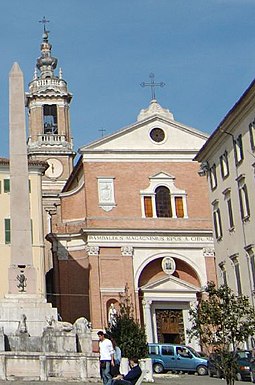History
Saint Septimius, supposedly martyred in 307, has been venerated as the first bishop of Jesi since the 15th century. [3] Saint Florianus, who was cast into the Esino in the Diocletian persecution, is also venerated (perhaps he is confounded with Saint Florianus who was cast into the Enus or Anisus). Other bishops of antiquity were Calumniosus (c. 647) and Honestus. Their relics were discovered in 1623.
The future emperor Frederick II was born in Jesi on 26 December 1194. His mother, Constance, Queen of Sicily, was on her way to join her husband, Henry VI, who had been crowned King of Sicily at Palermo on the previous day. At Jesi she was overcome by sudden labor pains, and, anticipating the birth of an heir, the people erected a pavilion for her in the town square, so that the birth might take place amid a large complement of witnesses. [4] Fifteen cardinals and bishops witnessed the birth of the baby Frederick. [5]
On 30 May 1247, Pope Innocent IV rejected the election of one of the Canons of the Cathedral Chapter, Armannus, as bishop of Jesi, on the grounds that the Canons were excommunicated due to their support of the Emperor Frederick II. One Canon, however, named Montanario, was loyal to the Holy See and had escaped to Ancona from Jesi; he notified the Pope that he elected the Franciscan Gualterio. Innocent ordered the Rector of the March of Ancona, Marcellino Aretino, and Bishop Philip of Fermo to investigate the election and consult with Canon Montanario, and provide the new bishop. [6] The Franciscan Gualtiero, an Englishman, was appointed. He was a friend of John of Parma, general of the order and patron of the Franciscan Spirituals. [7]
Bishop Severinus in 1237 laid the foundations of the new cathedral; [8] the old cathedral, dedicated to Saint Nicholas of Myra, was outside the city, and in the eighteenth century had fallen into ruin. [9] In its current form, the cathedral is the result of restorations and renovations carried out by Bishop Antonio Fonseca. [10]
The cathedral was and is administered by a Chapter, composed of a Prior and ten Canons. [11] Up until the middle of the 15th century the Canons were required to live in the Canonica, unless individually dispensed. Pope Paul II (1464–1471) dispensed the Canons from this obligation. [12] The best-known of the Canons was Marcello Cervini, who became Pope Marcellus II (1555). [13]
Gabriele del Monte (1554) introduced the reforms of the Council of Trent, which he had attended. His successors were Cardinal Camillo Borghese (1597), afterwards Pope Paul V; Cardinals Tiberio Cenci (1621) and Alderano Cybo (1656), noted for their benefactions; Bishop Antonio Fonseca (1724), who founded a hospital. Cardinal Caprara, afterwards Archbishop of Milan, who concluded the Concordat with Napoleon, was Bishop of Jesi (1800–02). He was succeeded by Antonio Odescalchi, who was deported to Milan by the French in 1809, dying in exile in Cesano Boscone in 1812. [14]
On 15 August 1972, by the Bull Qui apostolico officio, Pope Paul VI created the new ecclesiastical province of Ancona, and granted its archbishop the status of Metropolitan. The ecclesiastical province was assigned the suffragan dioceses of Jesi (Aesina) and Osimo (Auximana). [15]
Synods
A diocesan synod was an irregularly held, but important, meeting of the bishop of a diocese and his clergy. Its purpose was (1) to proclaim generally the various decrees already issued by the bishop; (2) to discuss and ratify measures on which the bishop chose to consult with his clergy; (3) to publish statutes and decrees of the diocesan synod, of the provincial synod, and of the Holy See. [16]
Bishop Marco Agrippa Dandini (1599–1603) held a diocesan synod in Jesi on 16 September 1600. [17] Bishop Tiberio Cenci (1621–1653) held a synod on 10 May 1626, [18] and, as Cardinal, another synod on 23 September 1649. [19] Cardinal Alderano Cybo (1656–1671) held a diocesan synod in Jesi from 4 to 6 July 1658. [20] Cardinal Pietro Matteo Petrucci held his first diocesan synod on 26—28 April 1683. He held his second diocesan synod in Jesi on 21 March 1695. [21]
On 23 April 1708, Bishop Alessandro Fedele (1696–1715) held a diocesan synod, whose decisions were published in 1713. [22] Bishop Antonio Fonseca held a diocesan synod in the Cathedral on 25 to 27 May 1727. The synodal decrees were published. [23] He held a second diocesan synod on 26 and 27 September 1741, and its constitutions too were published. [24] From 14 June to 16 June 1772, Bishop Ubaldo Baldassini, B. (1764–1786) held a diocesan synod, and published its synodal constitutions. [25]
Cardinal Carlo Luigi Morichini (1854–1871) presided over a diocesan synod on 15—17 November 1857. [26]
Bishop Oscar Serfilippi (1978–2006) held a diocesan synod in Jesi on 24 January 1982. [27]

The Archdiocese of Ancona–Osimo is a Latin Church ecclesiastical territory and metropolitan see of the Catholic Church in the Marche region of Italy.

The Archdiocese of Capua is a Latin diocese of the Catholic Church in Capua, in Campania, Italy, but its archbishop no longer holds metropolitan rank and has no ecclesiastical province. Since 1979, it is a suffragan of the Archdiocese of Napoli, i.e. no longer has its own ecclesiastical province nor metropolitan status.

The Archdiocese of Fermo is a Latin archdiocese of the Catholic Church in northern Italy, with its seat in the city of Fermo, Marche. It was established as the Diocese of Fermo in the 3rd century, and elevated to an archdiocese by Pope Sixtus V on 24 May 1589. The archiepiscopal seat is Fermo Cathedral. The current archbishop is Rocco Pennacchio.

The Roman Catholic Diocese of Ferentino existed until 1986, when it was united into the new diocese of Frosinone-Veroli-Ferentino.

The Diocese of Rieti is a Latin Church ecclesiastical territory or diocese of the Catholic Church in Italy. It is immediately exempt to the Holy See. Its cathedra is in St. Mary Cathedral in the episcopal see of Rieti.
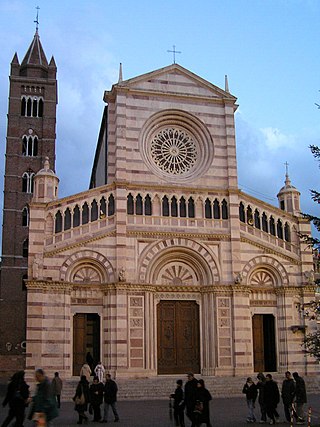
The Diocese of Grosseto is a Latin Church diocese of the Catholic Church in Italy, a suffragan of the archdiocese of Siena-Colle di Val d'Elsa-Montalcino, in Tuscany. Its current bishop is Giovanni Roncari, OFMCap.

The Diocese of Macerata-Tolentino-Recanati-Cingoli-Treia is a Latin diocese of the Catholic Church in Italy. It is a suffragan of the Archdiocese of Fermo.

The Diocese of Orvieto-Todi is a Latin Church ecclesiastical territory or diocese of the Catholic Church in central Italy. It was created in 1986 when the historical Diocese of Orvieto was united to the Diocese of Todi. The Diocese of Orvieto-Todi is immediately exempt to the Holy See and not part of any ecclesiastical province.
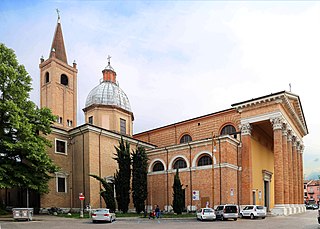
The Diocese of Forlì-Bertinoro is a Latin diocese of the Catholic Church in Romagna, Italy. Until 1986 it was known as the Diocese of Forlì, in existence perhaps from the fourth century. In that year the Diocese of Bertinoro was united to it. The diocese is suffragan to the Archdiocese of Ravenna-Cervia.
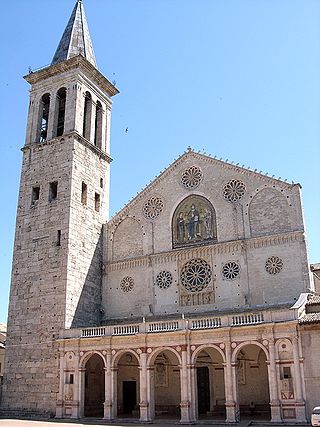
The Archdiocese of Spoleto-Norcia is a Latin Church ecclesiastical territory or archdiocese of the Catholic Church in Italy. Historically, it was the Diocese of Spoleto. Elevated to the status of an archdiocese since 1821, it is a non-metropolitan see and is immediately exempt to the Holy See.
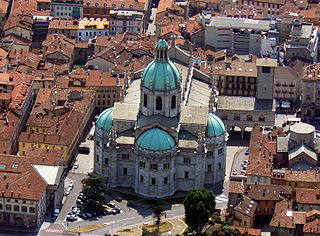
The Diocese of Como is a Latin Church ecclesiastical jurisdiction or diocese of the Catholic Church in northern Italy. It was established in the Fourth Century. It is a suffragan diocese in the ecclesiastical province of the metropolitan Archdiocese of Milan. The Bishop of Como's cathedra is in the Como Cathedral.

The Diocese of Foligno is a Latin Church ecclesiastical territory or diocese of the Catholic Church in Umbria, Italy. It is a suffragan diocese in the ecclesiastical province of the metropolitan Archdiocese of Perugia-Città della Pieve.
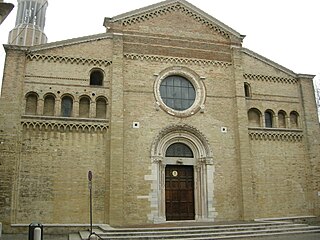
The Diocese of Fano-Fossombrone-Cagli-Pergola is a Latin diocese of the Catholic Church in Italy, created in 1986, when the historical Diocese of Fano was united to the Diocese of Cagli e Pergola and the Diocese of Fossombrone. It is a suffragan of the Archdiocese of Pesaro.

The Diocese of Senigallia is a Latin Church diocese of the Catholic Church in the Marche, Italy. It has existed since the sixth century. It is a suffragan of the archdiocese of Ancona-Osimo.
The Catholic diocese of Sarsina was a Roman Catholic ecclesiastical territory in Emilia-Romagna, northern Italy, seated in Sarsina, in the province of Forlì, some 32 km south-southwest of Cesena. The diocese was founded in the 5th century, and was suffragan (subordinate) to the archbishop of Ravenna. The diocese existed until 1986, when it was united with the diocese of Cesena.

The Diocese of Ascoli Piceno is a Latin diocese of the Catholic Church in the Marche. It has existed since the fourth century. Historically immediately dependent on the Holy See, it is now a suffragan of the Archdiocese of Fermo. There is, in 2015, one priest for every 1,074 Catholics.

The Diocese of Cesena-Sarsina is a Latin diocese of the Catholic Church in Emilia Romagna was created on September 30, 1986, after the Diocese of Sarsina was united with the historic Diocese of Cesena as a suffragan of the Archdiocese of Ravenna-Cervia.

The Diocese of San Severo is a Latin diocese of the Catholic Church in Apulia. It is a suffragan of the Archdiocese of Foggia-Bovino.
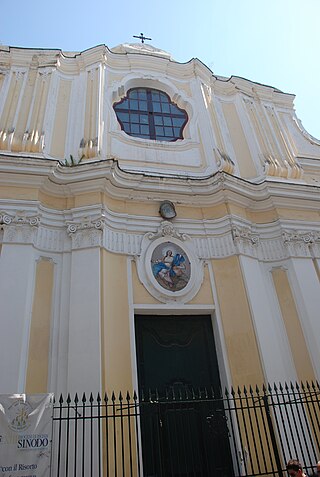
The Diocese of Ischia is a Latin diocese of the Catholic Church in Campania, southern Italy. It is a suffragan of the Archdiocese of Naples. The diocese comprises the entire island of Ischia, which contains seven communes divided into two circumscriptions. In 1743, the population was about 4,000. The city of Ischia constituted one single parish, with two religious houses of men and one of women. In 2018, the population of the town of Ischia was 20,118.

The Diocese of Anagni-Alatri is a Latin Church ecclesiastical territory or diocese of the Catholic Church in Lazio, Italy. It has existed in its current form since 1986. In that year the Diocese of Alatri was united to the historical Diocese of Anagni. The diocese is immediately exempt to the Holy See.
